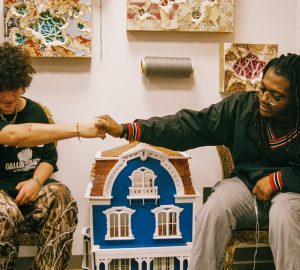SCAD students independently organize lecture, discussion
By Gray Chapman
 SCAD students have recently organized a series of open discussions called “Color Theory,” coordinated by resident assistants Solomon Chaison and Dru Phillips. The most recent “Color Theory” discussion met on April 22 at Spring House, where an estimated 40-50 SCAD students were in attendance. This discussion included a special guest lecturer, Bomani Armah, creator of the controversial rap song, “Read a Book.”
SCAD students have recently organized a series of open discussions called “Color Theory,” coordinated by resident assistants Solomon Chaison and Dru Phillips. The most recent “Color Theory” discussion met on April 22 at Spring House, where an estimated 40-50 SCAD students were in attendance. This discussion included a special guest lecturer, Bomani Armah, creator of the controversial rap song, “Read a Book.”
According to co-organizer Solomon Chaison, a second-year graphic design student, the “Color
Theory” discussions were begun as a way to inform the SCAD community about different cultures on campus. The goal, according to Chaison, is to “open minds and give insight” to students, and is more about sharing information than about debate or argument. Chaison said that the idea had been in
the back of his mind, but finally took form when he and Dru Phillips decided that SCAD students should be given an opportunity for open discussion about race and cultural differences. “Everyone is fair in the discussions. There isn’t really any arguing at all, even though the crowd is really diverse,” said Chaison.
Bomani Armah, who also goes by the name “D’Mite,” said that he was glad to participate in the session and encourage discussion about racial issues. According to Armah, he is “not a rapper, but a poet with a hip-hop style.” He said that it was his interest in both hip-hop culture and current social issues that lead him to create “Read a Book,” a rap that satirizes hip-hop artists like Lil John. The controversy and notoriety surrounding Armah’s work has lead him to public debate with figures like Jesse Jackson of the Rainbow/PUSH Coalition and Paul Porter of CNN.
According to Chaison, Armah’s video was shown in the first “Color Theory” session. It sparked much debate and he decided to contact Armah, whom he had met working in an after-school program in
Washington, D.C. In addition to releasing a new album, Armah also works in juvenile detention
centers teaching creative writing, conducts informational seminars on using hip-hop as an educational tool and writes editorials for the Washington Post. Armah said he is very active in both initiating
discussion of social issues and encouraging people to attack social problems at the root.“ I’m a 30-year-old black man, I have a family, I’m a business owner, I have no criminal record — but I don’t feel like I’m represented accurately by television and radio,” he said during the discussion on Tuesday. “I’m trying to create albums that represent that guy.”
Several students said they were engrossed in the discussion lead by Armah in Spring House. Many expressed appreciation for Chaison’s and Phillips’ initiative to provide the opportunity to students. “Last week, everyone in the room was involved and talking,” said Anthony Zollo, a-first-year sequential art student. “It was a great chance to talk openly about this kind of thing.”
Chasion said that he and Phillips plan to continue providing the discussions for SCAD students. “As RAs, we’re required to come up with events every month for our building. We just thought this one would be the most useful.”
Photo by Andrew Phillips
























